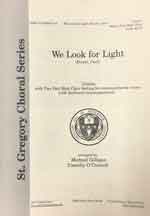We Look for Light
By Gregorian Chant; unison, with 2-part male choir setting for even-numbered verses
Author Gilligan, Michael
Author O'Connell, Timothy
This is an English-language setting of the Gregorian Chant known in Latin as Rorate Caeli,, an ancient hymn to be sung during Advent. Largely taken from the Book of the Prophet Isaiah, the verses are in the form of a dialogue between the people and God. The even-numbered verses, perhaps sung by the women in the choir, represent the voice of the people. The odd-numbered verses, perhaps sung by the men in the choir, represent the voice of God, who speaks each time in reply. After each verse, the people sing the refrain, "We look for light, O Lord our God. Show us the glory of your only Son."
Publisher Comments
As mentioned, throughout, this song is derived from Scripture, mostly the Book of Isaiah, in various passages. As in the Bible, We Look for Light represents a dialogue between God and his people. In Scriptural idiom, we approach God not as individuals but as members of his Church, as one body. That is the way God chooses to save us; and it is the way we come to him, to know his grace and to reach his kingdom.
At all times and among every nation, the one who reverences God and does what is right has been acceptable to God (cf. Acts 10:35.). Nevertheless, it was not God's plan to sanctify and save human beings as individuals with no relationship of any kind with each other. Rather, God intended to make them a people who would acknowledge him in truth and serve him in holiness (Constitution on the Church, #9).
In We Look for Light, the text and melody are united as a single, musical composition, as was common in Gregorian Chant. In English, the melody necessarily had to be adapted to conform to the word and sentence accent of the new idiom. Furthermore, the text is by no means merely a translation of the original; nor is it meant to be. In both music and text, then, this is a new composition, freshly derived from the Bible itself.
With regard to the even-numbered verses, sung by the men, it may be better not to use the organ or piano, since the melody is so simple. Furthermore, a capella singing has merit of its own; it sets the liturgy apart as especially solemn and reserved. Finally, the harmony in these verses is usually better appreciated when it is heard without accompaniment.
Otherwise, however, keyboard accompaniment is entirely appropriate, especially for the odd-numbered verses and the repeated refrain. In the Roman Rite, Advent is not a time of penance; use of the organ is not discouraged. Unlike Lent, Advent is a time when we wait "in joyful hope."
Since the themes of the liturgy in November correspond to the themes of December, it is appropriate to begin singing We Look for Light even in early November. From the Feasts of All Saints and All Souls to the Feast of Thanksgiving, to the final Sundays of Ordinary Time, to the Feast of Christ the King, the emphasis throughout is on the end of the world, the end times, the final harvest, the resurrection, and the glory of Christ who comes again.
During the Mass, when should We Look for Light be sung? Usually, an appropriate time would be during the preparation of the gifts. Especially if there is a collection and a procession of the gifts by the people, We Look for Light, with all its verses, would be just the right length. Furthermore, the reflective character of this hymn is well suited to this part of the liturgy.
Your choir members will be pleased that We Look for Light is printed in especially large print, for easier reading.
© 1994- by ACP Publications, All Rights Reserved


